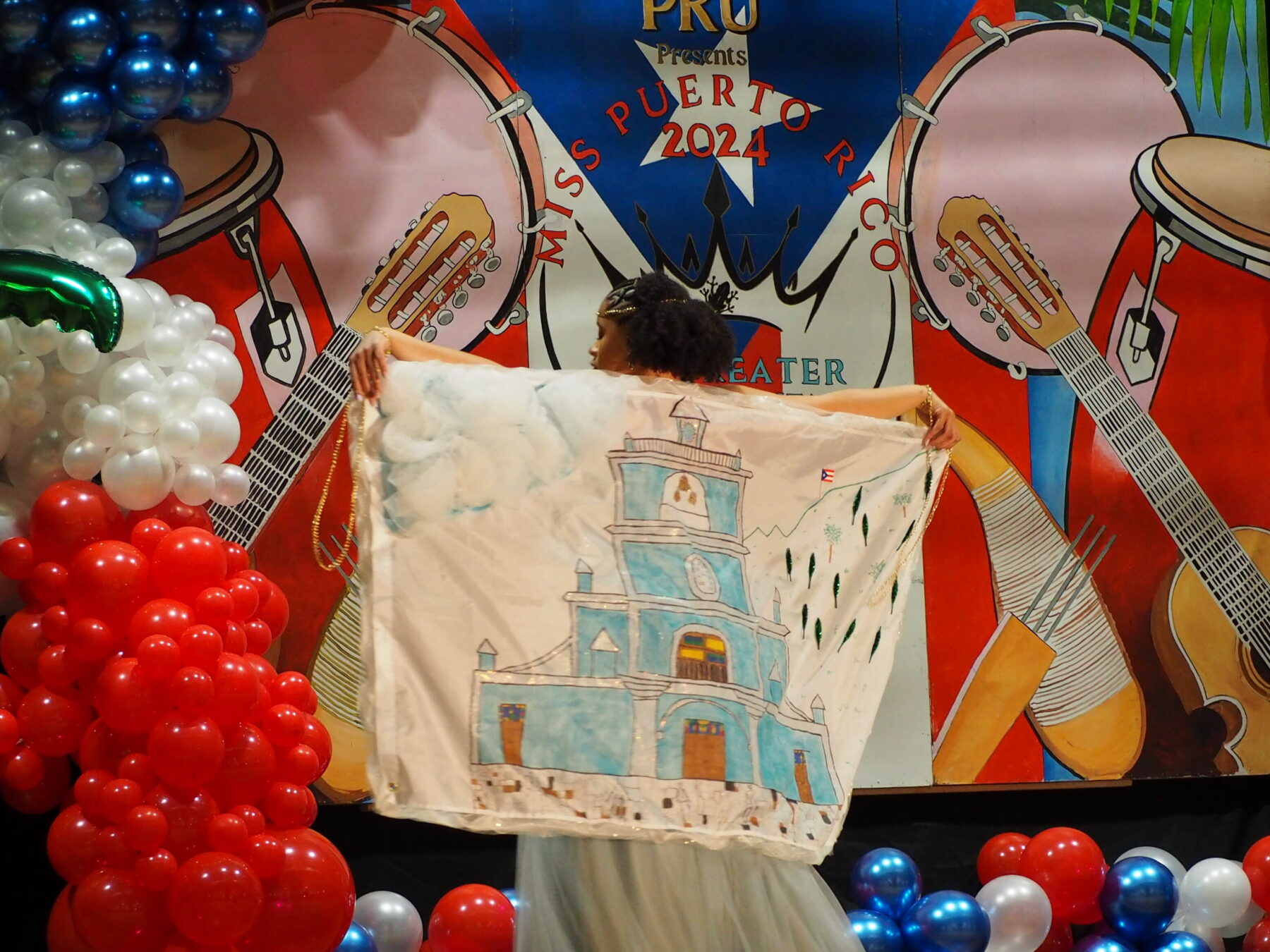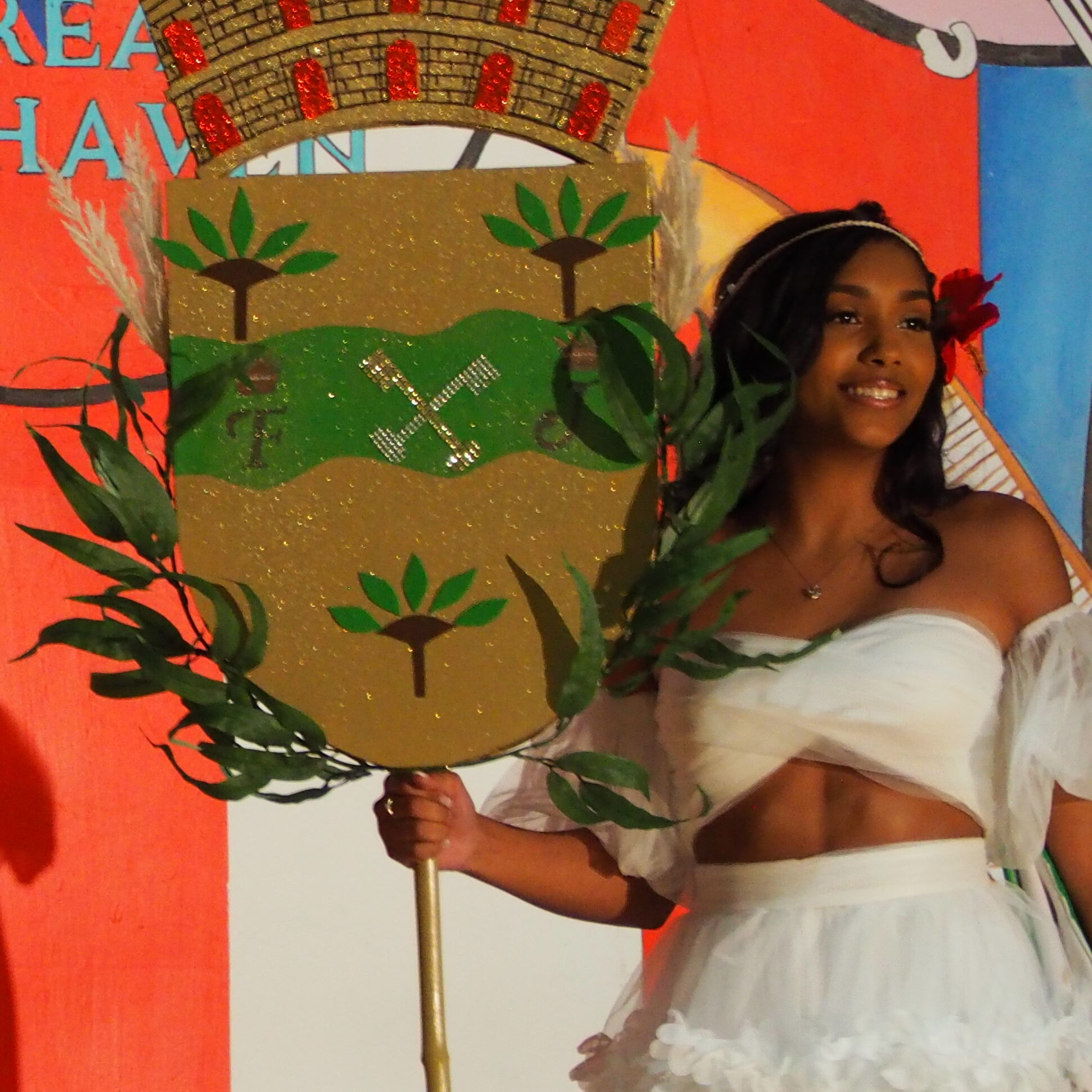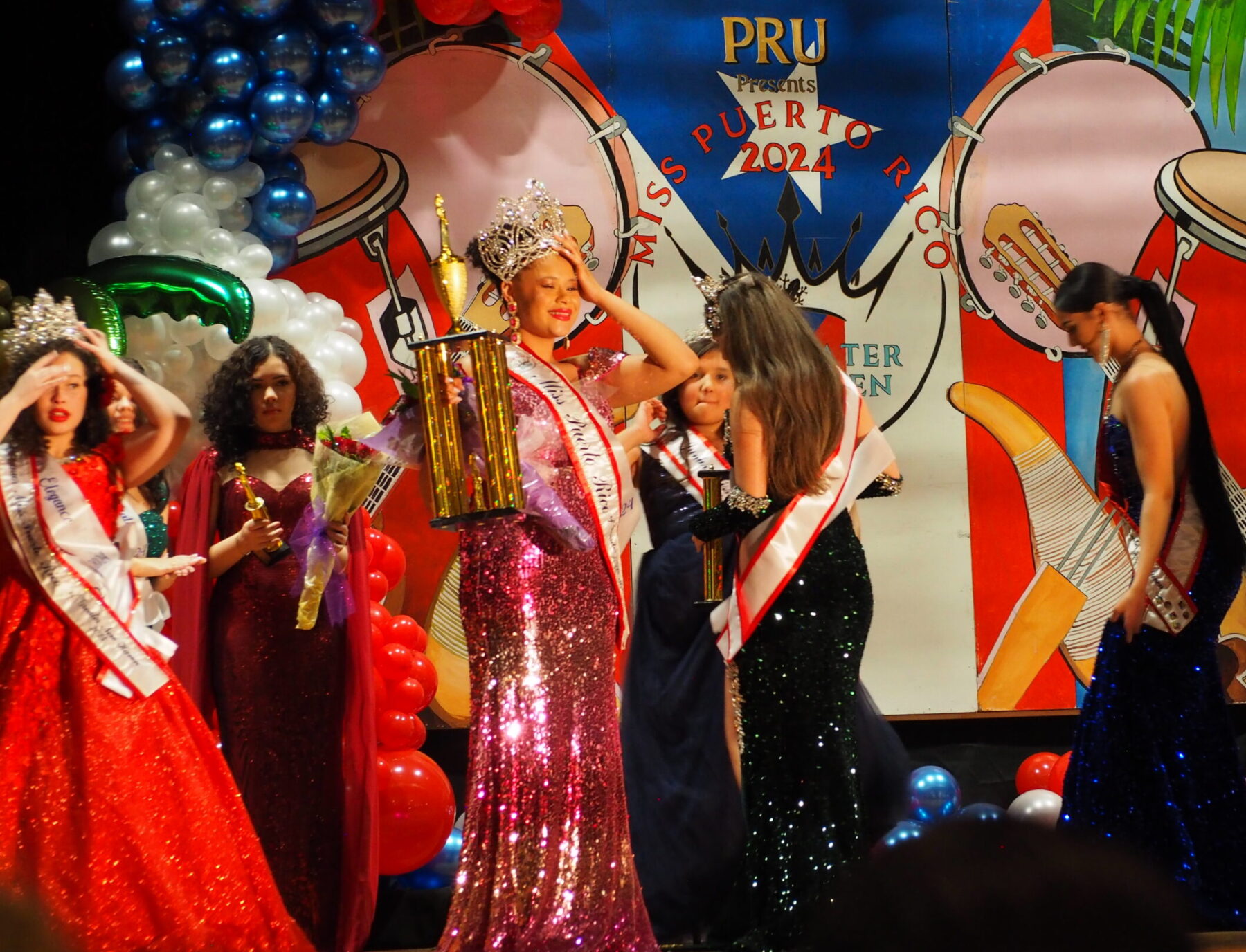I.
¡Buenas tardes, New Haven!
In Wilbur Cross High School’s vast auditorium, the salsa music halts. New Haven Mayor Justin Elicker steps up to the podium to share a few words. The family next to me whispers to each other impatiently—clearly, he is not who they are here to see.
As the first pair of young women strut onto the stage, heralded by Daddy Yankee’s “BONITA,” the woman next to me shrieks and stands up to record. “Sorry,” she whispers sheepishly, as the duo takes their positions and poses at either end. Far upstage, a large banner features images of güiros, cuatros, and tambores in front of the Puerto Rican flag. The instruments coalesce around an insignia: PRU Presents Miss Puerto Rico of Greater New Haven 2024.
The annual pageant, which traces its history in New Haven back to the nineteen-seventies, seeks to select a Miss and Junior Miss Puerto Rico to serve as role models for the city’s Puerto Rican youth and award them a scholarship prize. A dozen girls aged twelve to eighteen will each represent one of Puerto Rico’s seventy-eight municipalities, with their chosen pueblos corresponding to their parents’ or grandparents’ hometowns on the island. As they dance their opening salsa in a swirl of red and blue leotards, I notice their sashes: Miss Cayey. Miss Peñuelas. Miss San Juan. The atmosphere awakens a deep nostalgia in me—the music that colored my childhood on the island, the ritual of religiously watching the Miss Universe Puerto Rico broadcast with my family every year.
Here, over a thousand miles away from the island, these New Haven native girls a way to forge a Puerto Rican identity that is meaningful and true to them.
“We’re not just building our next reinas,” stresses Joe Rodríguez, president of Puerto Ricans United, the organization that has run the pageant for the past two years. “We’re building our next cultural ambassadors.”
II.
The Monday before the pageant, I sit in a crowded Lorenzo’s Ristorante Italiano, enjoying a pre-pageant dinner alongside contestants and their families. 17-year-old Alanna tells me about her first time visiting Cayey, Puerto Rico this past summer. She recalls strolling through the central plaza’s colonial Spanish buildings, listening to her great-grandmother’s stories. She traced the steps of her family’s history across the city, as though she were following a ghost.
Like the streams Cayey is known for, Alanna’s voice is bubbly and clear. Last year, she was the pageant’s first runner-up—the First Princess. She lets this motivate her. “I did this last year, and I almost won, which means I’m definitely going to win this year,” she says, smiling.
Though its current iteration is only in its second year, the history of New Haven’s Miss Puerto Rico pageant stretches back much longer.
Waves of migration formed Puerto Rican communities across the state starting in the nineteen-fifties—a decade marked on the island by economic uncertainty and federal crackdowns on nationalism and cultural symbols. In 1964, Connecticut held its first official Puerto Rican Day Parade in Hartford, to celebrate a diasporic culture at a time when it was manifestly under attack.

By the nineteen-seventies, local Miss Puerto Rico pageants took place in New Haven, Bridgeport, Waterbury, and more. The winners of each city’s pageant then competed for the state title, and for the honor of donning the crown and sash on their royal float at that year’s statewide parade.
But New Haven’s last pageant took place in 2008. And the last parade and festival on the New Haven Green took place just a year later. Magaly Cajigas, the former Miss Puerto Rico of New Haven 1992, explained to me that the volunteer-run statewide pageant had proven difficult to organize and fund. Many volunteers broke away to focus on their own city-level cultural programs. In New Haven, eventually, several community elders stepped down from their boards without leaving clear successors.
Almost a decade of dreadful silence elapsed before Puerto Ricans United was able to bring bomba and plena back to the New Haven Green in 2016. In 2022, Rodríguez approached Anika Russell and Samary Polnett, both mothers and former Miss Puerto Rico of New Haven contestants, to gauge their interest in reviving the pageant for the following year. Eagerly, Russell and Polnett signed on as co-directors.

Russell tells me she credits the pageant with inspiring her back in high school. “I was going to school out of district, and there weren’t many Puerto Ricans at my school,” she recalls. “I was very shy, I was very reserved, and I felt like this pageant, as a teenager, instilled some self-confidence, some leadership skills. It got me involved in my community.”
Now, she hopes to bring that experience to a new generation of girls. For these girls, scattered across the Greater New Haven area, most have had little contact with Puerto Ricans beyond their family circles—which may themselves be multiethnic or generations removed from the island.
III.
At the Miss Puerto Rico of Greater New Haven pageant, each act is judged on “cultural relevance” alongside creativity and overall presentation. From the pageant’s talent component, I recognize “Preciosa” rendered on saxophone, and “La Borinqueña” drawn across cello strings. I’m thrilled to see Miss Cabo Rojo Johanelyz dance a bomba, a traditional Puerto Rican dance; like the petals of a hibiscus flower ruffled by the breeze, her layered skirt blooms and withers around her body as she spins.
For Alanna’s act, she performs “Carnaval del Barrio” from Lin-Manuel Miranda’s musical “In the Heights,” her alto reverberating through the auditorium. Though her mother was born in Cayey, Alanna’s father is Black and from Connecticut. As an Afro-Boricua, she understands that this pageant, on its face, asks her to embody just half of her identity.
“Based on whoever is looking at me, they either think I’m Black or Puerto Rican; I’m somewhere in between. I like to tell myself that my ancestors on both sides were both taken from Africa, just, the ships landed in different areas,” Alanna says. “When people think of Puerto Ricans, they don’t think of someone that looks like me. They think of a specific, stereotypical Boricua, typical Latina; with the dark hair, the pale skin, and the brown eyes.”
The presence of this idealized Puerto Rican Woman seems to loom over all the girls. She is fuzzy—a phantom—but easily distinguishable by her fluent Spanish, sun-kissed complexion, and inborn ability to dance. She represents a woman who is unquestionably Puerto Rican—to whom Puerto Rican-ness offers no resistance.
I do not know what it’s like to have this Puerto Rican Woman peering over my shoulder. I’ve spent my entire life on the island, and I have always, more or less, taken my Puerto Rican-ness for granted. It’s never something to be questioned or proven. However, for girls growing up in New Haven who may not know that such a woman does not even exist on the island, this beautiful phantom can be harder to dispel.
In the three months prior to the April pageant, volunteers dedicate themselves to helping the girls prepare. They practice modeling, etiquette, even financial literacy. On Tuesdays, at Viva! Dance Center in West Haven, the girls learn salsa, bomba, plena, and other Puerto Rican dances from a former pageant queen. On Thursdays, they trade their dance shoes for notebooks, studying the history of Puerto Rico and their family’s pueblos.
13-year-old Lysella, the reigning Junior Miss Puerto Rico of Connecticut 2023 who is representing San Juan in the pageant’s Junior Miss category, recalls being bogged down by pageant homework. But the work paid off, she tells me, beaming in a ruffled orange-red jumpsuit. Lysella has only ever visited San Juan—the city both her mother and I grew up in—once, and remembers little apart from the strikingly blue sixteenth-century cobblestones lining the Old City’s streets. Still, she has learned much more about her pueblo and Puerto Rico’s history. Insistently, she talked to me about la Ley de la Mordaza, the law that made it a crime to display the Puerto Rican flag during the nineteen-forties and nineteen-fifties, and the billions of dollars in withheld federal aid to the island after 2017’s Hurricane María.
The pageant this year features a cultural costume component. Each dress transports the audience to one of the girls’ Puerto Rican pueblos: a ribbon-adorned fairy dress alludes to a famous Peñuelas legend; a shimmering leotard and lion mask pays homage to the carnivals of Ponce; a bedazzled boxer’s garb recalls that worn by Cabo Rojo’s Mayra Matos during her run as Miss Universe Puerto Rico 2009. Before the audience’s eyes, the white train on Lysella’s red dress morphs into a giant seashell that frames her, Venus-like, as she spins around to reveal the design of San Juan’s crest on its back.
When Alanna steps on stage in a floor-length light blue dress, I notice the tiny model skeletons peeking out from between the folds of her tulle skirt. “Under Iglesia Nuestra Señora de la Asunción, there’s three hundred to five hundred human remains,” Alanna had told me. In the auditorium, she turns around to reveal the face of the church, rendered in white and blue brushstrokes, before lifting her hands to the sky. They are bound in gold chains. An ode, I realize, to one of the deceased—a little Taíno girl, whose skull bears the green imprint of oxidized chains.
IV.
Miriam, the 2023 Miss Puerto Rico of Greater New Haven, glitters, her eyelids dusted with gold and her head crowned with gems. Reflecting on nearing the end of her reign, she’s nostalgic.
“There’s no better love than the love Boricuas can give you,” she tells me. Presenting herself as Miss Puerto Rico at cultural parades and festivals in New Haven and New York City showed her the vibrance of the wider Puerto Rican community, helping her to overcome her doubts about her ability to represent them.
“I was like, if I could speak Spanish, I know that I could really represent Puerto Ricans one hundred percent,” she recalled. “But then, that’s when I took that step back and I realized that, no, you can represent Puerto Ricans in so many other ways.” During her reign as Miss Puerto Rico, Miriam spoke at schools across the city, campaigned for autism awareness, and earned a spot on Connecticut’s Afro-Latino 30 Under 30.

Miriam fondly recalls spending the summers with her family in Caguas, Puerto Rico. She insists I should visit Plaza Palmer and stop by their giant birdcage—which, though I drive through Caguas frequently, I had never noticed. I ask her if she ever felt at home there. “It’s complicated,” she laughs. “Being there, I feel like it’s a part of where I’m supposed to be. But where I belong is in [New Haven], my city. That’s how I feel.”
Miriam is not a Puerto Rican Woman, that ethereal, fuzzy-edged figment. She is a true representative of her community, a young woman who embodies the particular struggles and strengths of New Haven’s Puerto Rican youth.
The point of the pageant is not to replicate an “authentic” Puerto Rican cultural experience— one that is indistinguishable from what exists on the island. Alanna, Lysella, and Miriam have grown up navigating concrete jungles and braving Northeastern winters, not fanning themselves during heat waves and trying to sleep through coquí symphonies. The pageant is just as much about building a distinct New Haven Puerto Rican community as it is about connecting the girls to the roots common to Puerto Ricans all over the world.
Lysella takes pride in her newfound community. “I felt disconnected from my own people. Now I feel more connected, ‘cause…look who I’m around.”
Alanna describes Puerto Ricans United as a “large family,” and her fellow contestants as “sisters.” She loves how different they all are, and how fiercely they support one another. “Even on the day of the pageant, right before you go on stage everyone is like, ‘Good luck, you got this!’”
V.
In her sequined pink dress, Alanna walks gracefully. For someone who insisted that the evening gown was her least favorite part of the pageant, she’s doing a great job of hiding it. Her smile does not falter as she draws her final question from the box: “Why do you deserve this title?”

“I deserve this title because I’ve grown a lot in the past year. I’m not the same girl who was crowned First Princess last year, and I’ve learned through my mistakes and my failures to become a more poised, but also intellectual Miss Puerto Rico. As Miss Puerto Rico, I will—I intend to—create a different image of Puerto Rican women. That we don’t have to be fiery and extra, that we can be passionate, and we can be precise, and we can be intellectual. We can be smart, and we can pursue studies.” The crowd erupts into a deafening rumble.
“I want to be a role model for young women,” Alanna finishes.
At the time, Alanna did not know whether she would win the title. She still cannot believe she can. “It’ll sink in later tonight,” she admits breathlessly. The massive crown atop her head has remained since it was placed there by Miriam. Lysella beams not too far behind, the Junior Miss Puerto Rico sash glittering against her red gown.
I don’t know exactly how the new Miss and Junior Miss Puerto Rico feel at this moment. But as I watch a colorful swarm of friends and family storm the stage, I can’t help but believe that, at the very least, we’re speaking the same language.
Ingrid Rodríguez Vila is a sophomore in Branford College and a Verse Editor for The New Journal.

